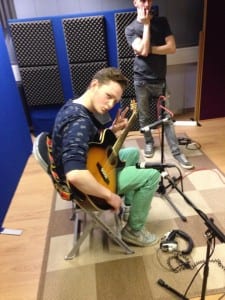While I was doing my Mix, I encountered a few problems because I basically just took a stab at it and hoped for the best rather than slowly worked on it and I basically had to do it 2 or 3 times before I realised I needed to stop, slow down the process and basically start again.
Once I realised this, I took a step back, listened to the track a few times and then thought to myself, which tracks could I actually drop to make the overall song sound better. The first track that I took out was one of the Bass tracks – this would leave me with two Bass tracks, which would leave me with more than enough Bass to work with to make the track sound good. After I turned my attention to the guitar tracks. At first there was three two guitar tracks, an electric guitar track and an acoustic guitar track, the electric guitar had been double tracked – this means it had been recorded once, copied and then inserted into the project again. I thought that to make the song sound more authentic and less harsh on the ears, I would remove the electric guitar altogether and leave just the acoustic guitar in the song for my final mix. I feel that this was a good option because once I removed the guitar, the song sounded a lot better already and had potential to sound great, I felt that the electric guitar was holding the song back quite a bit and therefore needed to be removed.
I then edited how the song would start, I played with the idea that the first verse would come straight in and the instruments would pick up in chorus, for the rest of the song, but I could not get the transition right – I do feel if I left myself more time to do my mix, that I would have tried harder to get this idea off the ground. I then had the Bass starting the song by itself – similar to the original, but using the bass rather than the guitar; but after a few playbacks like this, I felt that there was a better way to start the song, so I settled on having the bass drum start and then all the instruments coming in together when the drums do the snare/floor tom build up.
After this it was then time to add the effects and edit each track how I wanted. The first track I went to was the solo guitar, this is because since the week we recorded it I knew exactly how I wanted it to sound, so I went there first. I used EQ so tighten the sound up rather than having loads of odd frequencies that wasn’t needed, I then turned the tracks up, so the solo was sitting just slightly above the rest of the mix – this is so it catches peoples attention and gets people listening more intently. I then turned my attention to the vocals, I liked the idea that if I put reverb on the vocals that they would sound a bit distant and make it sound like they were recorded in a big hall, so that’s what I done, however I listened back and chose to tone down the reverb so there’s just a slight reverb that is only noticeable in certain parts of the track. With the rest of the tracks, I used EQ and compression to tighten and tidy up the song so it sounded more rounded rather than rough around the edges.
